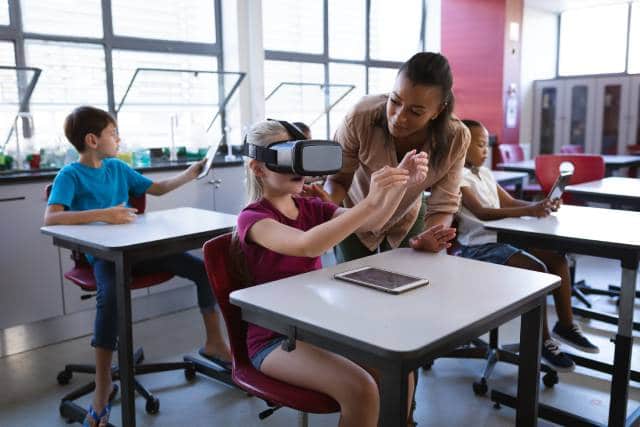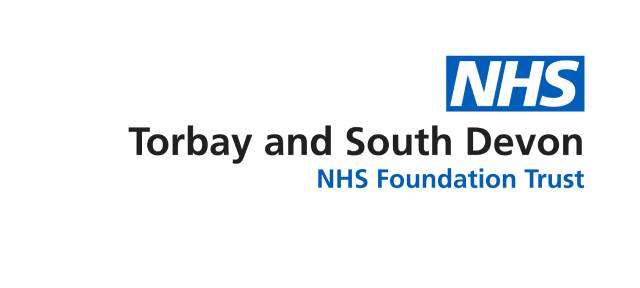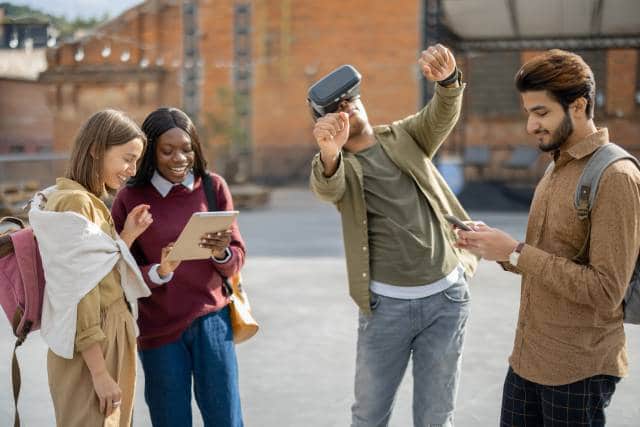
The Best Ways XR Is Used For Patient Education (2022)
- June 23, 2022
- 9:37 pm
Table of Contents
The Uses & Benefits of XR for Patient Education
The Quickest Way To Understand XR for Patient Education

Below we explore the uses of XR For Patient Education.
We have explored the learning potential of VR for healthcare staff in a prior blog piece.
The parallel experience for patient-focused education has an ever-increasing remit with exponential onward potential.
Visitors to healthcare settings/unwell patients returning to work may benefit from pre-visualisation of pathways of care and the ability to receive shared insights and re-creations of unique perspectives and illnesses.
Patient education brings an experiential awareness of soft skills critical to social and healthcare success such as effective interaction and communication between health and care staff to patients and service users.
VR can assist in providing contexts which emphasise the importance of human connectivity, a theme that cannot be underestimated where caring professions and patients are concerned.
Experiences which give insights to a pathway of care or pre-surgical visualisation, such as the Alder Hey Previsualisation Study will have learning benefits for both patients and service provider/clinician.
Patients from Alderhey reported that using a VR intervention reduces anxiety by helping visualise an understanding of a process before having to undergo it physically.
For the clinician, this will increase empathy with patients undergoing the therapeutic journey.
The study results and discussion also offer an opportunity for reviewing environments, interactions and processes from a different perspective, with patient-driven insight which can result in more focused, patient-centred changes in service development.
With respect to previsualisation; skills can be drawn from the more complex CGI (computer-generated imagery) built experiences and accessible applications of VR and XR content.
Low-cost 360-degree video equipment has been used and adopted by several hospitals, including education and simulation teams to build focused in-house training content.
A key benefit of VR from the health professional perspective is being able to rehearse, test, role-play, and respond to materials which evoke emotions and a feeling of immediacy and subject immersion.
XR material testers can experience a range of scenarios and test out ways to respond, but without real-life consequences.
Suitable scenarios include breaking bad news, such as new cancer and multiple sclerosis diagnoses or discussing the impending death of a family member.
This in turn leads to helpful and appropriate learning opportunities which can work through scenarios that can be increased in intensity.
XR can also be used for reinforcing clinical knowledge and for careers guidance, visiting different clinical and laboratory settings.
Using XR over existing digital media enables an increased immersion which can lead to a more realistic user experience and result in a more authentic response with personalised learning.

Through the Patients’ Eyes - Project at Torbay and South Devon NHS Foundation Trust: How VR can be used to Enhance Empathy and Humanistic Skills for Healthcare Staff
Having taught on MRCP PACES Ahead for just under a decade, HAUD’s Dr Sajini Wijetilleka has successfully exemplified that understanding patient perspectives and narratives are critical to successful medical education and training.
Using VR and XR environments to experience the lived conditions, feelings and emotions of a person can help healthcare workers empathise with patients extensively.
Successful clinicians have the ability to connect and appreciate a patient’s experience and communicate using this understanding.
Empathy is an essential healthcare soft skill that can transform the quality of the relationship between the patient and healthcare professional.
Practically-speaking, an empathetic consult can translate into a better conversation, supporting an essential “what’s important to you?” approach to care with a focus on the patient’s ideas, concerns and expectations.
Using XR and VR for patient education and discussing the scenarios afterwards provides a valuable moment of reflection and consideration for the health and social care workforce.
Through experiencing the ‘opposite’ perspective; a shared appreciation of a condition or lived narrative can help engagement with a treatment or care plan, having positive implications on patient outcomes.
Empathy training and, in the wider context human factors sessions, are a vital focus in healthcare education and training.
Challenges from the COVID-19 pandemic aside, reflective time is at a premium due to service delivery pressures, burn out, lack of consistent training, combined with the challenges of teaching humanities focused curriculum as a consistent key skill.
A focus on service delivery and mandatory training leads to a reduction in protected time where practitioners can reflect on their experience and empathise with patients.
Since 2015, the introduction of patient perspective 360-degree video scenario content, created at Torbay and South Devon NHS Foundation Trust’s VR Lab, has provided unique insights and reflective learning for trainees to access as part of their educational simulation training.
This has complemented the SIM teaching as an additional interactive experience, delivered in both VR and as a desktop experience.
Course students are shown first-person perspective films from the patient’s point of view, using VR demonstrations.
Examples provided include the patient’s journey through to the intensive care unit and the different communication styles experienced by the patient along the way, from paramedics, nurses and doctors.
A recent tutorial allowed participants to see a simulated patient perspective during COVID-19, observing the effect PPE has on communication and the patient journey.
Patients have also experienced ageing with their carers, using the Embodied Labs project.
Immersive experiences offer improved outcomes for all ageing individuals, positively impacting the health of trainees and others through experiential engagement to help material users solve relevant challenges.

The Application of VR in Patient Education for Autism
Multiple studies have demonstrated how VR and XR mediums have assisted autistic groups to explore communication needs, social skills development, educational outcomes, practising skills such as road safety and vocational outcomes such as job coaching.
VR can help to simulate real-world situations and contexts in safe and predictable ways.
Developers have the ability to control, shape, and tailor VR interventions to participant needs and local contexts.
VR has been used across a range of environments and scenarios including social development and parenting, such as Talking Sense (which is popular with autistic children and their parents), transitions to employment, travel training and general educational materials.
Newbutt and colleagues (2020) discovered that through the co-creation of educational experiences in classrooms for autistic children, VR helped them to relax, remain calm and opened opportunities for previewing a real-world experience in VR.
Research into Deep, a breath controlled VR experience, demonstrated that this intervention helped to reduce disruptive classroom behaviour.
This finding encapsulates the potential that VR could have for neurodiverse young people; patients will benefit from reduced anxiety, promoting calm and visiting places, such as healthcare environments virtually before a physical visit.
The Gold group (2021) have explored the role of VR to support autistic patients for preoperative anxiety in addition to improved patient, caregiver, and healthcare satisfaction of a preoperative patient experience.
House et al (2020) have studied the effects of pre-operative visualisation before epilepsy surgery (stereotactic electrode implantation) and Koo et al (2020) have used interactive 360-degree video that has been explored and deployed in various healthcare pathways to reduce anxiety and better educate the patients on what to expect: examples include attending an MRI scan and pre-arthroscopic surgery visits.
It is a well known fact that anxiety can have significant implications and cause apprehension pre-procedure.
This can extend the time taken to complete the procedure, may require significant reassurance from healthcare staff/general anaesthetics or the procedure may even need to be cancelled to be repeated at a later date.
This can have a domino effect on other patients’ schedules and incur additional costs to the already burdened UK healthcare system.

XR Growth in the Soft Skills and Clinical Education Environment
VR HMD’s offer ecological validity (i.e. feeling natural in a space), immediacy and immersion.
This means that the specific clinical education and soft skills that health care professionals need to develop can be powerfully enhanced with XR patients education approaches.
XR also enables patients to preview and experience the environment of a hospital (and/or aftercare) in a way that can reduce anxiety and help patients to acclimate to new experiences in familiar settings.
Having local educators/healthcare settings create their own bespoke content offers a powerful patient participatory and engagement-led approach to creating localised and meaningful educational tools.
Patients being educated in the care they are about to receive, or staff having a greater opportunity to understand the needs of patients from their
perspectives will use their empathy to improve onward care.
This is a scalable opportunity, extendable to patients across the healthcare and care home sectors and more.
Educated patients are engaged and empowered; encouraging co-produced resources and interventions will support HAUD’s ultimate aim: a health service designed by patients for patients.

About Us
I hope you enjoyed this post about the use of XR for Patient Education.
We are HAUD, Your VR Healthcare Related Software Developer.
We aspire to draw from our extensive experience in the gaming and entertainment industries.
Our developers are adept at storytelling, using gamification and creative technology as powerful interventional tools for eliciting cost-efficient and beneficial patient, carer and clinician outcomes.
Feel free to take a look around and reach out to us if you want to learn more about how we create custom XR software for you.